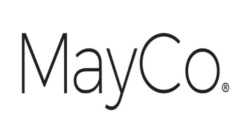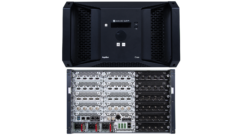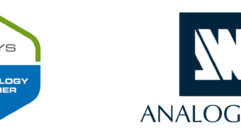
Analog Way Octo-Vue FX
Sep 1, 2006 12:00 PM,
By Jeff Sauer
Single-scaler switcher has universal (input) appeal
Last issue, I reviewed a new Roland Edirol video switcher/mixer with a design heritage that comes out of the broadcast video world. This issue, I examine another switcher — Analog Way’s new Octo-Vue FX — with similar capabilities, but a very different methodology. Both products accept SD and HD video, as well as RGB computer inputs, and both can mix video singles with a variety of effects. However, as a more traditional professional AV switcher, the Octo-Vue FX takes a more rudimentary approach to getting the job done, and it doesn’t offer true seamless switching between all inputs. But it costs less than half the price, and offers great value for specific applications where it is needed.

The Octo-Vue FX is the latest and grandest product in Analog Way’s Octo series of AV switchers. The series of products started with the Octo-Plus and now features logo insertion (Octo-Logo), smooth transitions (Octo-Fade), expanded effects capabilities (Octo-FX), and the more modest and affordable Octo-Quattro. The Octo-Vue FX boasts capabilities from all the other flavors, and it adds a preview output that yields the ability to see a source on a preview monitor before taking it live. That’s a standard feature among production switchers, but not so among pro AV switchers, hinting at a maturing industry.
The common thread through the entire Octo line, excluding the four-input Octo-Quattro, is the eight universal video inputs with audio, although connectors vary. For the Octo-Vue FX, connectors include one DVI-I connector for digital and analog inputs, and seven 15-pin analog RGB inputs. Splitter cables and menu configurations can allow any input to accept any common source, either computer or video, from composite to HD component. However, input 7 adds two BNCs for composite or S-Video, and input 8, on the front of the unit, adds RCA composite and a standard S-Video five-pin connector. The Octo-Vue FX also includes RS-232 and an optional Ethernet port ($390).
Ultimately, the Octo-Vue’s universal inputs offer more options than the Edirol unit, although that’s not too surprising given the wide variety of sources that an AV product needs to accommodate. While Edirol dips into pro AV with its data inputs, the focus is ultimately on switching between live camera feeds. Moreover, production switchers, including the Edirol system, tend to leave audio to a dedicated audio panel. More typical of pro AV switching, Octo-Vue FX handles audio with dedicated audio inputs for each video source.
The Octo-Vue does mix and match a bit, pairing unbalanced stereo mini plugs with inputs 1, 2, and 8 and balanced/unbalanced MCO connectors for inputs 3-7. There is also an auxiliary MCO audio input for a separate microphone, CD player, or some other audio-only source.
SEAMLESS SWITCHING, SOMETIMES
The Octo-Vue has two switching modes: fast switching and seamless. True seamless switching can only happen between a reference computer input (and only using either input 1 or 8) that matches the output resolution and another source. You cannot switch seamlessly between two non-reference video sources, such as two live camera inputs.
Even in seamless mode, switching between any two non-reference sources requires fast switching or fading to black (or some set color) before fading in to the new source. Alternatively, a clean-cut mode can freeze the onscreen outgoing frame briefly before switching to the new source (a so-called A-X roll instead of A-B roll), thereby avoiding the fade to black/color.
True seamless switchers can always perform smooth-flowing transitions between any two sources, but inevitably carry a much larger price tag. Analog Way can sell the Octo-Vue FX for much less, in large part because it only has one built-in scaler. Pro AV switchers with two scalers do exist, but their prices are closer to that of the Edirol system ($12,995). With the Octo-Vue, clean cuts, fast switching, and the use of the reference input ultimately make the most of the single scaler, and they yield generally pleasant visual results. You’ll need to judge whether they match your specific needs, but for many typical pro AV switching environments, such as conferences, houses of worship, and corporate meetings, the trade-off is more than acceptable. On the other hand, larger-scale houses of worship that demand television-like production quality will probably prefer the seamless model.
Physical differences between the Octo-Vue FX and the Edirol similarly cater to different needs. Where the Edirol lays the input buttons out across a switching panel with a tactile fader bar for transitions, the Octo-Vue features a more typical pro AV array of much smaller, front-panel push buttons. If you’re doing a lot of quick switching between sources, the larger buttons and fader bar of the Edirol will have a clear advantage. For typical presentations, though, the Octo-Vue certainly meets the need.
Interestingly, with the new preview output, the methodology between the Octo-Vue and Edirol is actually similar. The current “take” input button is lit, and to switch, you depress a new input, thereby sending it to the preview monitor. Hitting “take” (or moving the Edirol’s fader bar) brings the new source live.
FANCY-FREE FEATURES
The Octo-Vue FX does not feature the plethora of fancy transitions and wipe patterns that you’d expect from a production switcher, but it does have a lot of practical features for pro AV users. For example, logo insertion allows you to position and size a graphic image (while keying out the background), but it also allows you to set opacity (as with a semi-transparent TV channel lower-right “bug”), fade it in and out, and store up to eight different images. You can overlay titles, made simply with Microsoft Paint or PowerPoint slides, and fade them in and out, as well. You can also set an entering and closing effect for picture-in-picture, as well as adjust position and size. Most importantly, you can preview what each will look like on the preview monitor before going to air.
All of these features are available through the modest LCD screen on the panel’s front, but many are more easily accomplished through Analog Way’s included software utility. It can communicate with the Octo-Vue FX via either RS-232 or the optional LAN connection, and control the entire device and all its menus much more fluidly than the scrolling knobs on the unit itself. As with past devices I’ve tested, Analog Way’s image processing is very clean, and scaling is very good. Color reproduction is also very good and true.
Priced at less than $6,000, the Octo-Vue FX strikes a nice price performance balance, and should serve most typical pro AV users well. The addition of the preview output is shrewd in that it addresses the increasing sophistication of an industry that now expects higher production value. Indeed, Analog Way recently debuted a new tactile switcher panel, Axion, complete with fader bar and dedicated-button presets that will be able to control one (or more) Octo-Vues. That product won’t ship for several months, and the price had yet to be announced at press time, but it shows where the industry is headed — and Analog Way is clearly moving in that same direction.
PRODUCT SUMMARY
Company: Analog Way
www.analogway.com
Product: Octo-Vue FX
Pros: Good value for pro AV switching, excellent quality
Cons: Not true seamless switching between all inputs
Application: Typical pro AV users
Price: $5,990
SPECIFICATIONS
Max active channels: 8
Video inputs: DVI-I, 15-pin (7); BNC composite (2), BNC, S-Video, RCA composite, S-Video five-pin
Audio inputs: Three stereo mini, six MCO balanced/unbalanced
Output: DVI-I, 15-pin RGB; five-pin MCO audio, 15-pin preview out
Comm ports: RS-232, Ethernet optional
Image quality adjustments: For video: brightness, contrast, hue, color, under/overscan; for data: black, red, green, blue, phase, clock
Image positioning (inc. PIP): H pos, V pos, H size, V size, aspect ratio
Effects: Fast-switch mode, seamless cut mode, PIP, title insertions, logo insertion, fade
Audio control: Individual channel gain
Dimensions (H×W×D): 1.7″×17.3″×11.8″
Weight: 7.7lbs.
Accessories: Cables, software
Warranty: Three-year parts and labor










